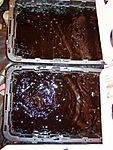C
Classy@Home
DWC: Are airstones really an effective way to increase DO?
IMVHO - yes...
Fine bubble airstones w/ lots of output have produced some very large, white, solid rootballs in my grows.
I've gotten rootporn extraordinaire with dual 6" airstones in my dwcs.
I'll continue to use them - works for me...
IMVHO - yes...
Fine bubble airstones w/ lots of output have produced some very large, white, solid rootballs in my grows.
I've gotten rootporn extraordinaire with dual 6" airstones in my dwcs.
I'll continue to use them - works for me...




